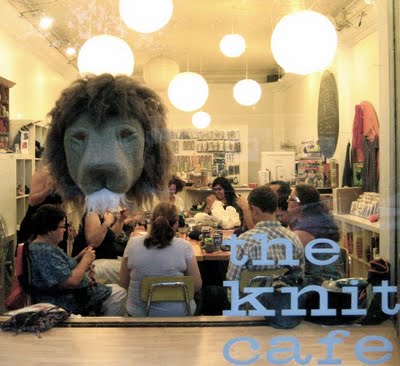
Two decades old!!!!
Thank you to all our patrons and students – you are the reason we are still here!
An abbreviated history of The Knit Cafe
The Knit Cafe opened its doors on October 8, 2003. On Queen St. West near Ossington Ave in Toronto, we chose our first home because it was close to where we lived. The beautiful space with original hardwood floors and a tin ceiling was a delight – we painted the store front orange! Back then we rubbed shoulders with small creative businesses and galleries. It was not the fashionable part of Queen St, it was a bit feisty and a bit scruffy – kinda like us.

The “us” in this story was Matthew Muller, Andrea Dorman, Kate Austin, and Kristin Ledgett. We were pals and roomies; we were knitters. This picture is the earliest one I could find. It was taken for a National Post article. At the time, knitting shops were few and far between so we were news!

We set to work developing our community, which was the “raison d’être” for The Knit Cafe right from the start. We wanted to have a place for crafty folks to gather, ask questions, show and tell and share. A weekly social gathering turned into a twice a week gathering – so many stitches, so many laughs.

The Knit Cafe on Queen St West was a cafe. We served frothy lattes, and snacks. We hosted some delicious food events like our monthly High Teas – thanks to talented chef Sharon Bergey. We also had classes, so many classes. It makes me very happy to think about all the people we have helped learn their favourite craft and how that might be inspiring and nourishing them still.

Iwona Gontarska was our very first employee at The Knit Cafe and it did not take long before we found her indispensable! She was soon to become the 5th partner in The Knit Cafe experiment. If you come into the shop now you will meet Iwona, or Kristin who are still the hands on deck. If you are really lucky you will see Maurie Todd who has been working with us since these Queen Street days. Maurie is a treasure!

Because we are arty we have dallied in textile art pieces throughout the years. While we were on Queen St West The Knit Cafe participated in the very first Nuit Blanche Art Event and many thereafter. The exhibit that was most memorable for many folks was made in 2007. “Knit City” was a knitted recreation of some of the iconic buildings in Toronto. This grainy photo shows Honest Eds, OCAD, the Gladstone Hotel, Trinity Bellwoods Gates, The Knit Cafe, and the CN Tower, all made with knits and purls.
Our Queen facing window was also the perfect spot to showcase the work of other artists. If you would like to know more about these exhibitions, check out THIS BLOG POST

It hasn’t always been kittens and rainbows at The Knit Cafe. There have been lean times, and very lean times, and there was that flood, and ten years in, we were forced to leave our Queen Street home.


The good news is that The Knit Cafe found its way to Roncesvalles Ave. Yes, the space was smaller; true, we could not set up another cafe but being part of the Roncey community was resurrecting!!!

We settled into our new digs, expanded our classes, hosted pop ups and guest instructors, and started a yarn club. In this picture Kristin is setting up the window display for The Polish Festival on Roncesvalles.

Roncesvalles was not destined to be our forever home though. In April 2022 we were on the move again. This time we ended up at 1350 Dundas West, where we hope to stay. Moving away from Roncesvalles was hard but we love our new, bright space, that has so much more room for hosting classes and events.

…and now, it’s October 2023 and the Knit Cafe is about to have their first social gathering since pre-Covid times. You are invited. Please come and help us celebrate our 20 years.
The Knit Cafe’s 20th Birthday Party
Friday October 13, 6pm-9pm
1350 Dundas St. West
bring something to stitch!
Craftily yours
Kristin








































